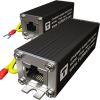This forum and thousands of others on the interweb can provide you all of the information as it relates to proper grounding techniques and best practices. Having said that, the Internet is also filled with lies and bad information.

The topic of grounding isn't very complicated so long as you understand the basics.
- Low resistance Earth ground (<5 - 25 Ohms)
- Single point connection to Earth ground
- All devices are interconnected, bonded to the above using recommended / approved hardware
- Environmental's are taken into account and installed to conform to whatever IP rating while also reducing the impact of corrosion.
The OP's initial question(s) are actually multi part, one being proper NEC / CEC grounding procedures. While the other is about SPD protection which is related to grounding. In the big picture (generally speaking) nobody has to spend a ton of money on proper grounding because if the home / structure was built to NEC / CEC it would meet said code as it relates to proper grounding.
But, this is the real world and NEC / CEC and Human's don't always implement or follow through in insuring proper grounding is done. Regardless, if we ignore for just a moment the home is properly grounded than a couple of simple and free things can be done by anyone in the home.
Assuming you're not dumb and feeble . . .
Go outside and verify the ground rod is sound and properly
Bonded and shows no signs of corrosion. That the same ground and its ground wire is properly connected and secure to the inside of the homes electrical panel. If in doubt torque every screw down per the panel makers specification which includes all neutrals within the panel.
Next, go to every outlet and switch and validate all wires are secure and fastened correctly to their respective end device.
Having done the above you at least know all the wires are sound and tight. This in no way means you know you have a low resistance Earth ground present! The only way you'll ever know is to have the same Megged out to determine how much resistance is present and if it meets the threshold
At the time of the NEC / CEC.
Ideally it should be zero ohms which is near impossible to achieve based on soil type, moisture, temperature etc.
Regardless, if you have any doubts you can spend $50.XX and pound in a few more ground rods into the ground (properly spaced) and have the same bonded to one another. Doing so will reduce the resistance dramatically and will provide the home with a low resistance Earth ground.
As it relates to SPD (Surge Protective Devices) . . .
Nobody has to spend a dime on any of this . . . People also don't need to spend a dime on any form of insurance either. Those living in Lightning Alley would beg to differ as it relates to needing both low resistance Earth grounding and the use of a tiered SPD system.
They would also affirm the proper insurance and coverage is paramount to be in place and enforced!
On the polar opposite those who live in Tornado Alley will not be the first people to say you don't need a safe room etc.
If anyone intended to invest any money toward a SPD do so within your means and where that money is well spent. In America lots of POCO's will offer or sell you a Type 1 SPD installed at the meter base. If that's the case just scream at them and say
Take my money because its money well spent!
Type 2 SPD's are installed at the Service Panel (Breaker)
Both of the above are intended to sacrifice themselves during large voltage spikes. As such they are not intended to protect any sensitive electronics. Type 3 are POU (Point Of Use) at the outlets such as a power SPD strip etc. Generally speaking they are designed and rated to sacrifice themselves at a much lower voltage level.
This is good because the Type 1 / 2 isn't designed for that . . .
Type 4 are typically installed at a device level such as a AC, HVAC, Fire Control, Alarm, etc.
As others have touched upon all of the above can easily costs hundreds to tens of thousands of dollars. The average person can simply buy something now and build on that later. Nothing wrong going that route but would say
Spend your money once.
There are thousands of products from Great companies to fly by night that are just - shit.
Why???
Because we as a human race have a completely different mind set as to designing and building things. It's not about making the best and to last forever - its about good enough - making more money again & again.





 The topic of grounding isn't very complicated so long as you understand the basics.
The topic of grounding isn't very complicated so long as you understand the basics.